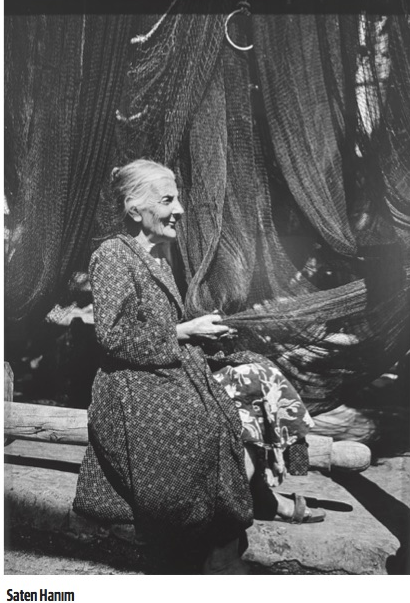The sea and fishermen form a common theme in Ara Güler's photographs of Istanbul. The exhibition of a selection of photographs taken in the old fishermen's neighborhood of Kumkapı under the title 'Kumkapı Fishermen' was inspired by Ara Güler's series of articles titled 'Kumkapı with Armenian Fishermen' published in Jamanak newspaper in 1952, taken when he was still a young photojournalist. Among his famous signature photographs of fishermen and net menders captured sometimes in groups or single, there are also women who immediately catch our eye, the most striking one being Merametci Saten Hanım.
MERİ TEK DEMİR
For Ara Güler, his photographs were a record of history. Among the visual history he created, the images most identified with him were black and white Istanbul landscapes. Ara Güler says that what we see today as 'old Istanbul' is not actually the old Istanbul, and that he was slightly able to capture the old state of the city. The Istanbul landscapes captured through his lens over the years allow us to discover both forgotten and new stories. After all, if photography is the immortalization of a moment, the moment immortalized through the photographer's eye gains new meanings every time it meets a new viewer, from that viewer's perspective. On May 7, 2024, while visiting the 'Kumkapı Fishermen' exhibition at the Ara Güler Museum, the Armenian women in the fishermen's world that we encountered made us rethink women's work force and existence from the perspective of Parrhesia Collective.
The sea and fishermen form a common theme in Ara Güler's photographs of Istanbul. The exhibition of a selection of photographs taken in the old fishermen's neighborhood of Kumkapı under the title 'Kumkapı Fishermen' was inspired by Ara Güler's series of articles titled 'Kumkapı with Armenian Fishermen' published in Jamanak newspaper in 1952, taken when he was still a young photojournalist. Ara Güler took many photographs of daily life and workforce in this neighborhood, which he visited many times until it was destroyed by the coastal road construction. In this exhibition, where we also have the opportunity to see Güler's photo notes and similar documents from his years at Jamanak, there are famous photographs that have become his signature, as well as lesser known photographs and even images that are being presented to the audience for the first time. Among his famous signature photographs of fishermen and net menders captured sometimes in groups or single, there are also women who immediately catch our eye, the most striking one being Merametci Saten Hanım.
Saten Hanım resembled a graceful woman whose portrait might have been painted by a master painter not in the 1950s, but centuries ago. However, she did not pose for her portrait to be painted. She was a working woman; as the title of the photograph says, she was working as a merametci, that is, mending fishing nets. She was looking into the distance with a subtle smile, working with fatigue and wisdom reflected on her face over the years. Crafts such as patchwork, embroidery, and needlework are often seen as women’s chores in the realm of the home, rather than representing arts. For centuries, the male-dominated history of art has preferred to view women as passive figures who are painted, rather than as active artists who produce art. Although women have produced in the field of visual arts, they have been limited to a few genres, and this problem has become visible with the interpretation of art history from a feminist perspective.
The craftsmanship I saw in Saten Hanım’s photograph somehow reminded me of the chores traditionally attributed to women, bringing to mind the issue of women being overlooked in the visual arts. I felt as though Saten Hanım was not just engaged in the workforce but also practicing art. However, none of these thoughts changed the fact that, despite her age, Saten Hanım was a working woman in a male-dominated profession, in a fishermen’s neighborhood. It is known that Ara Güler sometimes waited for hours, even days, to capture the right light and the moment. I wonder if he waited to fit Saten Hanım into the frame, and what inspired him to take this shot? Did he find Saten's craft similar to art like I did, was he impressed by the elegance of her posture or her age, or did he just want to record her profession? Saten Hanım, seen in all her elegance in this frame, was also practicing a profession. She had not been objectified for her beauty but had a tired and worn face. She was working with the grace of an artist. In another frame captured in the early 1960s, Hayganus Mayrik, a Merametci, like Saten Hanım, is also a working woman; there is a similar delicacy in her work reflected in the photograph. In another frame, we again see merametci women, but their names are unknown.
Women's identity and women's work force have become invisible in the world of fishermen, just like in many other areas of life. Since fishing evokes a male-dominated order, it is only natural that the priority in the minds of visitors to the 'Kumkapı Fishermen' exhibition is not what women in that neighborhood are interested in, but what they spend time and effort on. Nevertheless, Saten Hanım and Hayganus Mayrik, residents of a neighborhood that has long since disappeared, will make visitors think about those women, and the fact that they put effort in such a job despite their age will create new meanings today. As I said at the beginning, the moment of taking the photograph as well as its meeting with others can add new meanings and stories to the frame. Perhaps these women had to work and their labor was invisible and unknown at the time. Today, in the history recorded by Ara Güler, they appear as female representatives of the workforce of that period and world.

